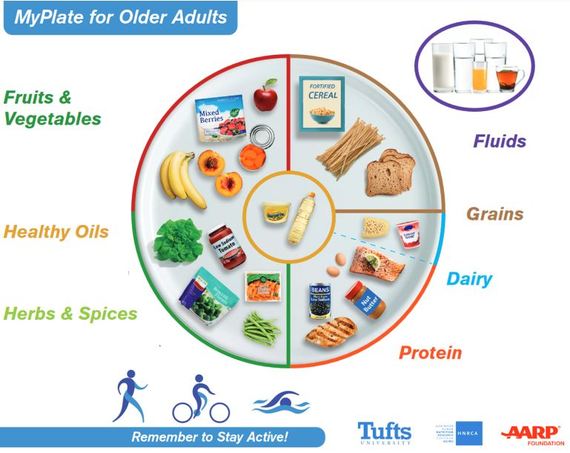The MyPlate for Older Adults just got a facelift thanks to nutrition researchers at Tufts University with support from the folks at the AARP Foundation. I love this new healthy eating visual because it not only colorfully depicts the five basic food groups: fruits, veggies, grains, dairy and protein. But it also emphasizes other important foods and nutrients that we need as we age.
The latest science suggests that we should consume healthy oils, gulp more healthy beverages, consume less salty foods, and keep moving throughout the day. Let's see what's in this new MyPlate.
Starting at the left side of the plate, the visual prominently reminds us that half of our plate should be chock-full of fruits and veggies. Produce is rich in nutrients and compounds that not only fight heart disease, but also certain cancers, stroke, diabetes and obesity.
Tip: You don't have to eat fresh fruits and veggies to stay fresh. Unseasoned frozen produce, low sodium canned veggies and fruit canned in juice are all nutrient-rich sources. The best produce for your dollar is to buy what is on sale. The more produce you can get for your buck, the more you will consume.
Moving clockwise on the plate, make sure that your grain choices are more often whole grains to get more fiber in your diet. Most older Americans are skimping daily on fiber.
Tip: Choose whole grains over refined grains by buying 100 percent whole grain cereals for breakfast, whole wheat bread at lunch, and brown rice rather than white rice for dinner.
Next on the plate, remember to consume three servings of dairy foods daily in order to boost your calcium and vitamin D intake. Both are nutrients that your bones crave but most older Americans are falling short of in their diets.
Tip: Use reduced-fat milk rather than a coffee creamer in your morning java. The creamers may lighten up your coffee but pale in comparison to milk for providing vitamin D and calcium. Choose yogurts with added vitamin D. While milk is automatically fortified with vitamin D, not so for many yogurts.
The last spot on your plate should be devoted to muscle-building protein. Meat and poultry will serve up the protein you need with less heart-unhealthy, saturated fat. Swap in fish for at least two meals weekly to reap the benefits of heart-protective, omega-3 fatty acids.
Tip: Choose lean cuts of protein, such as roast beef, and skinless poultry. Substitute canned salmon or tuna for cold cuts at lunch to help you meet your weekly fish quota.
Outside the MyPlate is a fluid visual to remind us to drink throughout the day. As we age, our thirst mechanism isn't as sharp as it was in our younger years meaning our body could be in need of hydration although we are not feeling thirsty.
Tip: Skip the sugary beverages such as soda and use lower calorie beverages, such as water, to stay hydrated. Coffee, teas, and soups will all add fluids to your diet.
Spice up your life with herbs and other spices as substitutes for salt. Blood pressure not only naturally rises with age but also with a high sodium diet. Chronic high blood pressure increases your risk for stroke and heart disease.
Tip: Dump the salt out of your shaker and fill it with a no-sodium herb blend such as Mrs. Dash. Don't buy pre-seasoned meats, poultry and grains. Instead, use your new seasoning shaker to add some zip to your meals.
Lastly, remember to move. Adults need at least two and a half hours of moderate-intensity activity such as brisk walking weekly. Even better, remember to move daily.
Tip: Do your errands by foot rather than in your car. Running low on milk? Lace up your sneakers and walk to the corner store to get a quart.
For more healthy tips, click here for a fun interactive MyPlate.
Follow Joan on Twitter: @JoanSalgeBlake
Earlier on Huff/Post50:
"


